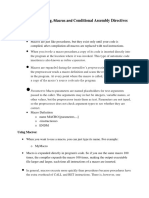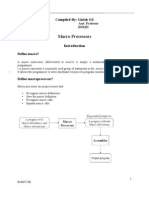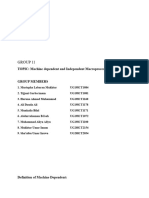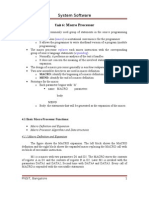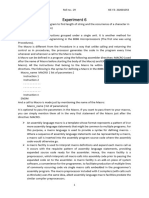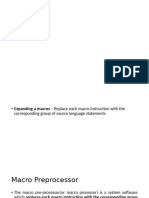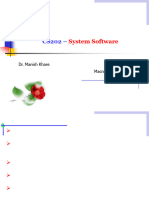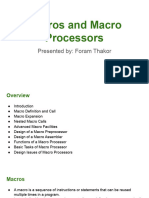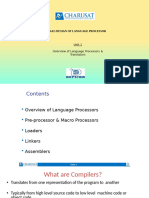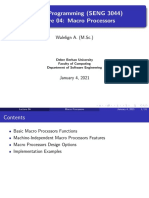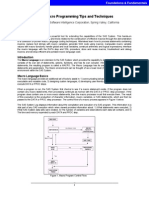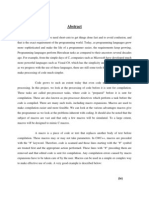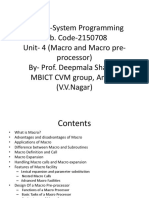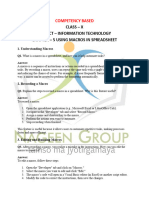Macro and Macro Processors
Macro and Macro Processors
Uploaded by
kanaiya valviCopyright:
Available Formats
Macro and Macro Processors
Macro and Macro Processors
Uploaded by
kanaiya valviCopyright
Available Formats
Share this document
Did you find this document useful?
Is this content inappropriate?
Copyright:
Available Formats
Macro and Macro Processors
Macro and Macro Processors
Uploaded by
kanaiya valviCopyright:
Available Formats
Macro and Macro Processors:
Introduction:
A macro is a prewritten piece of code that represents a sequence of instructions or
statements. It allows programmers to define reusable code segments and expand them
wherever needed, saving time and effort. A macro processor is a tool or software
component that processes macros within a program or source code.
Macro Definition and Call:
A macro is defined using a specific syntax and naming convention. It begins with a macro
definition statement, which specifies the macro name and its parameters (if any). The body
of the macro contains the instructions or statements to be executed when the macro is
expanded.
To use a macro, a programmer invokes it by its name and provides the required arguments
(if any). This invocation is called a macro call. The macro call is replaced by the expanded
code during the macro expansion phase.
Macro Expansion:
Macro expansion is the process of replacing macro calls with the corresponding macro code.
When a macro call is encountered in the source code, the macro processor scans the macro
definition, substitutes the arguments, and inserts the expanded code in place of the macro
call.
Nested Macro Calls:
A macro call can contain another macro call within its arguments. This is called nested macro
calls. When expanding nested macro calls, the macro processor recursively expands the
innermost macro first and then expands the outer macro calls.
Advanced Macro Facilities:
Macro processors often provide advanced features to enhance their functionality. These may
include conditional macro expansion, iteration constructs, macro libraries, parameterized
macros, macro conditionals, and more. These facilities allow macros to be more flexible and
powerful in their usage.
Design of a Macro Preprocessor:
A macro preprocessor is responsible for processing macros before the actual compilation or
interpretation of the source code. It scans the source code, identifies macro calls, expands
them, and produces an expanded version of the code. The design of a macro preprocessor
involves defining its syntax, handling macro definitions and calls, managing macro libraries,
and ensuring efficient macro expansion.
Design of a Macro Assembler:
A macro assembler is an assembler that supports the use of macros in assembly language
programs. It extends the capabilities of a regular assembler by allowing the use of macros
for code reuse and abstraction. The design of a macro assembler involves integrating macro
processing capabilities into the assembler, defining the syntax for macros in the assembly
language, and ensuring proper expansion of macros during assembly.
Functions of a Macro Processor:
A macro processor performs several essential functions, including:
1. Macro definition: Allows programmers to define macros and their parameters.
2. Macro expansion: Replaces macro calls with the expanded macro code.
3. Argument substitution: Replaces macro parameters with the provided arguments.
4. Error handling: Detects and reports errors related to macro processing.
5. Conditional macro expansion: Enables conditional inclusion or exclusion of macros.
6. Macro library management: Provides a mechanism to store and retrieve macros from
libraries.
7. Macro nesting: Supports the invocation of macros within other macros.
Basic Tasks of a Macro Processor:
The basic tasks of a macro processor can be summarized as follows:
1. Scanning the source code for macro calls.
2. Locating the corresponding macro definitions.
3. Expanding the macro calls with the macro code.
4. Substituting the macro parameters with the provided arguments.
5. Repeating the expansion process until no more macro calls exist.
Design Issues of Macro Processors:
When designing a macro processor, several issues need to be considered, such as:
1. Macro expansion order: Determining the order in which nested macros are expanded.
2. Macro scoping: Resolving conflicts between local and global symbols within macros.
3. Macro debugging: Providing tools and techniques for debugging macro-expanded code.
4. Macro naming conventions: Defining rules for naming macros to avoid conflicts and
improve readability.
5. Macro parameter passing mechanisms: Choosing the method of passing arguments to
macros (e.g., by value or by reference).
Features of Macro Processors:
Macro processors may include various features to enhance their functionality, such as:
1. Conditional assembly: Allowing conditional inclusion or exclusion of code based on certain
conditions.
2. Iteration constructs: Supporting looping or repetitive operations within macros.
3. Variable substitution: Replacing symbolic names with their corresponding values or
addresses.
4. Text manipulation: Providing facilities for string manipulation and text processing.
5. Macro libraries: Allowing the organization and reuse of macros in libraries.
6. Symbol table management: Handling symbol tables and their associated attributes.
Macro Processor Design Options:
There are different design options available when implementing a macro processor,
including:
1. One-pass macro processor: Expands macros in a single pass without requiring any forward
reference resolution.
2. Two-pass macro processor: Performs two passes over the source code, allowing forward
reference resolution and improved error detection.
3. Recursive macro expansion: Supports recursive invocation of macros within macros,
enabling greater flexibility.
4. Macro processor as a separate tool: Designing the macro processor as an independent
component that can be integrated with different compilers or interpreters.
5. Macro processor integrated with the compiler: Integrating the macro processor directly
into the compiler or interpreter to streamline the entire compilation process.
Two-Pass Macro Processors:
A two-pass macro processor involves scanning the source code twice. In the first pass, the
macro definitions are collected, and the macro calls are replaced by placeholders. In the
second pass, the placeholders are expanded with the corresponding macro code, and the
resulting expanded code is generated. This approach allows forward references to macros
and ensures correct expansion.
One-Pass Macro Processors:
A one-pass macro processor expands macros in a single pass over the source code. It may
use various techniques to handle forward references, such as generating temporary labels or
using look-ahead mechanisms. One-pass macro processors are generally simpler to
implement but may have limitations in handling certain complex macro constructs and
forward references.
In summary, macros and macro processors provide a powerful mechanism for code reuse
and abstraction. They allow programmers to define reusable code segments, expand them
wherever needed, and enhance the flexibility and productivity of software development.
The design and implementation of macro processors involve various considerations, such as
macro expansion order, scoping, debugging, and the choice between one-pass and two-pass
approaches.
You might also like
- SimVision UserGuideDocument346 pagesSimVision UserGuideAnonymous pHi4dX0% (1)
- Manual de Operaciones-MK9Config 3 Instrukcja 3.1.8.7 enDocument34 pagesManual de Operaciones-MK9Config 3 Instrukcja 3.1.8.7 enInnovación TECHNo ratings yet
- System Programming AsignmentDocument11 pagesSystem Programming AsignmentnandankarkinshukNo ratings yet
- Unit IV System SoftwareDocument10 pagesUnit IV System Softwaresilicongmaster7060No ratings yet
- System-Software Unit IVDocument9 pagesSystem-Software Unit IVpalanichelvam100% (8)
- Exp 9 SPCCDocument14 pagesExp 9 SPCCwork.mihirkateNo ratings yet
- UNIT IV Macro ProcessorDocument14 pagesUNIT IV Macro Processorelias ferhanNo ratings yet
- Macro ProcessorDocument44 pagesMacro ProcessorDanielLuci100% (1)
- Macros and DirectiveDocument7 pagesMacros and DirectiveAbdul MoeedNo ratings yet
- LPDocument18 pagesLPAnusha deviNo ratings yet
- Ch6 Macro ProcessorsDocument4 pagesCh6 Macro ProcessorsRama Muniswara Rao ENo ratings yet
- Ch4 Macro ProcessorsDocument33 pagesCh4 Macro Processorsakbisoi1No ratings yet
- SP 11Document50 pagesSP 11Anonymous V0TkkvWNo ratings yet
- SS Macro ProcessorDocument24 pagesSS Macro Processoringaleabhijeet2010No ratings yet
- Macro Part1Document32 pagesMacro Part1Anver S RNo ratings yet
- SP Unit2 RNPDocument103 pagesSP Unit2 RNP404badshah404No ratings yet
- Module 5Document26 pagesModule 5aswkh00videosNo ratings yet
- Notes of System ProgrammingDocument36 pagesNotes of System ProgrammingJaspreet SinghNo ratings yet
- Macro ProcessorDocument22 pagesMacro ProcessorYogesh Yogi100% (1)
- Macro Processor NotesDocument23 pagesMacro Processor Notessebinbenjamin100% (1)
- SP 11Document50 pagesSP 11Saurabh IyerNo ratings yet
- CH4 - MACROPROCESSORSDocument18 pagesCH4 - MACROPROCESSORSsisayyohannes997No ratings yet
- Aliyu Na ManshDocument4 pagesAliyu Na Manshaabdurrahaman647No ratings yet
- System Software Notes 5TH Sem VtuDocument25 pagesSystem Software Notes 5TH Sem VtuNeha Chinni50% (2)
- Macro Processors: Basic Function Machine-Independent Features Design Options Implementation ExamplesDocument18 pagesMacro Processors: Basic Function Machine-Independent Features Design Options Implementation ExamplesCharan SainiNo ratings yet
- Macro ProcessorDocument53 pagesMacro ProcessorJeena Mol AbrahamNo ratings yet
- MP Experiment 6Document2 pagesMP Experiment 6TANMAY KenyNo ratings yet
- System Software ModuleDocument37 pagesSystem Software ModuleFhvxgNo ratings yet
- Macro Preprocessor Part 1Document33 pagesMacro Preprocessor Part 1Anila JohnsonNo ratings yet
- Module 5Document65 pagesModule 5alaina2026No ratings yet
- ch4 MacroDocument53 pagesch4 Macroakbisoi1No ratings yet
- Macro_PreprocessorDocument75 pagesMacro_PreprocessorMegha BNo ratings yet
- SPCC Ia1Document6 pagesSPCC Ia1vapog80368No ratings yet
- SPCC CheatDocument1 pageSPCC Cheatvapog80368No ratings yet
- Ch. 6 Macro ... All PartsDocument43 pagesCh. 6 Macro ... All PartsV100% (1)
- System Software: Dr. Manish Khare Macro ProcessorsDocument33 pagesSystem Software: Dr. Manish Khare Macro Processorshoneykanna2024No ratings yet
- Macro 1Document8 pagesMacro 1Atul Sharma100% (1)
- System Software Module 2Document156 pagesSystem Software Module 2arunlalds0% (1)
- Department of Computer Science and Engg. System Programming and System Administration Sem-6Th Section-B (Notes)Document23 pagesDepartment of Computer Science and Engg. System Programming and System Administration Sem-6Th Section-B (Notes)Nikhil ChhillarNo ratings yet
- Macros and macro processorDocument43 pagesMacros and macro processordrmadhavpvtNo ratings yet
- Experiment No 3 - DONEDocument6 pagesExperiment No 3 - DONEvolturb007No ratings yet
- Macro Processors: Unit - IvDocument87 pagesMacro Processors: Unit - IvdevilaliNo ratings yet
- Unit 1-Overview of Language Processors and TranslatorsDocument71 pagesUnit 1-Overview of Language Processors and Translatorsbtechgaming05No ratings yet
- SAS Macro Language ReferenceDocument385 pagesSAS Macro Language ReferenceMoataz DeiabNo ratings yet
- Chapter FourDocument30 pagesChapter FourTigist AlemuNo ratings yet
- SAS Macro Programming Tips and Techniques: Kirk Paul Lafler, Software Intelligence Corporation, Spring Valley, CaliforniaDocument8 pagesSAS Macro Programming Tips and Techniques: Kirk Paul Lafler, Software Intelligence Corporation, Spring Valley, CaliforniaNagesh KhandareNo ratings yet
- Unit-IV-Macro Processor - Sri EshwarDocument105 pagesUnit-IV-Macro Processor - Sri EshwarVeningstonk Ageesh100% (2)
- Hands-On SAS Macro Programming Tips and TechniquesDocument9 pagesHands-On SAS Macro Programming Tips and TechniquesimranNo ratings yet
- System Software Unit 6: Macro Processor Book: System Software, 3 Edition, Pearson Education by Leland L. Beck & Dhanabalachandran ManjulaDocument3 pagesSystem Software Unit 6: Macro Processor Book: System Software, 3 Edition, Pearson Education by Leland L. Beck & Dhanabalachandran ManjulaKrishnapriya MenonNo ratings yet
- Macro ProcessorDocument68 pagesMacro Processorshubforall100% (3)
- MacroDocument48 pagesMacronadar uthayakumarNo ratings yet
- Systems Programming NotesDocument62 pagesSystems Programming NotesSwadesh AadityaNo ratings yet
- MACRO and ASM-DIRECTIVES (Unit4spmacro-170906062957 PDFDocument62 pagesMACRO and ASM-DIRECTIVES (Unit4spmacro-170906062957 PDFJani ServiniNo ratings yet
- SAS Macro Language Reference PDFDocument385 pagesSAS Macro Language Reference PDFSudhapantnagarNo ratings yet
- Module 5 NotesDocument63 pagesModule 5 NotesT A AsmaNo ratings yet
- SAS Macro Programming Tips, Tricks and TechniquesDocument9 pagesSAS Macro Programming Tips, Tricks and TechniquesRajasekhar ReddyNo ratings yet
- MacrosDocument348 pagesMacrosmunny000No ratings yet
- Class X Competency Based Information Technology Chapter - 5Document3 pagesClass X Competency Based Information Technology Chapter - 5nileshzaware80No ratings yet
- SPCC - 3Document10 pagesSPCC - 3Ian ThomasNo ratings yet
- SAS Macro Programming Made Easy, Third EditionFrom EverandSAS Macro Programming Made Easy, Third EditionRating: 3.5 out of 5 stars3.5/5 (3)
- Microsoft Excel 2021 Programming Pocket Primer: A Comprehensive Guide to Mastering Excel VBAFrom EverandMicrosoft Excel 2021 Programming Pocket Primer: A Comprehensive Guide to Mastering Excel VBANo ratings yet
- 1) - System VulnerabilityDocument7 pages1) - System Vulnerabilitykanaiya valviNo ratings yet
- System Software3160715 HandbookDocument124 pagesSystem Software3160715 Handbookkanaiya valviNo ratings yet
- Chapter:1 Introduction To Internet of Things (Iot)Document16 pagesChapter:1 Introduction To Internet of Things (Iot)kanaiya valviNo ratings yet
- Web Mining and Other Data MiningDocument2 pagesWeb Mining and Other Data Miningkanaiya valviNo ratings yet
- Time Table ManagementDocument5 pagesTime Table ManagementDivesh KatariaNo ratings yet
- VMware Examquestions 2V0-21 19D v2020-06-16 by Annie 51q PDFDocument24 pagesVMware Examquestions 2V0-21 19D v2020-06-16 by Annie 51q PDFCirce RomeroNo ratings yet
- Co Over ViewDocument263 pagesCo Over Viewbhargavsap4No ratings yet
- Devices For UpgradeDocument414 pagesDevices For UpgradeSuds NariNo ratings yet
- Userguide Galaxy SiiDocument202 pagesUserguide Galaxy SiiT. BattleNo ratings yet
- Operating SystemsDocument5 pagesOperating SystemsNicholas DavisNo ratings yet
- Similar To Technology Vocabulary #2 Multimedia Crossword - WordMintDocument2 pagesSimilar To Technology Vocabulary #2 Multimedia Crossword - WordMintdixitmbNo ratings yet
- Keyboard-Based Control and Simulation of 6-DOF Robotic Arm Using ROSDocument5 pagesKeyboard-Based Control and Simulation of 6-DOF Robotic Arm Using ROSNIKHIL SHINDENo ratings yet
- Lec 3Document9 pagesLec 3King VaibhavNo ratings yet
- NRP 23 Sep 2023 Amjad AliDocument176 pagesNRP 23 Sep 2023 Amjad AliKhizar ShahNo ratings yet
- Avaya Aura System Manager Overview and Specification Release 81x Issue8 Feb08 2021Document71 pagesAvaya Aura System Manager Overview and Specification Release 81x Issue8 Feb08 2021Anil BaghelNo ratings yet
- So 4tsh Bs EnkeiDocument2 pagesSo 4tsh Bs EnkeiAwan NugrohoNo ratings yet
- 4.gang of FourDocument4 pages4.gang of FournarikottamonlineeditorsNo ratings yet
- Bharat College Online Admission Form CircularDocument2 pagesBharat College Online Admission Form CircularShakil FangariNo ratings yet
- Corjl Digital Product Instructions & DocumentationDocument16 pagesCorjl Digital Product Instructions & DocumentationAdriana VNo ratings yet
- Adam Bensman The Copywriters 6-Figure Income SprintDocument5 pagesAdam Bensman The Copywriters 6-Figure Income Sprintمحمد حامدNo ratings yet
- Core Java Notes: Chapter-1, 2,3 Features of JAVA EnvironmentDocument31 pagesCore Java Notes: Chapter-1, 2,3 Features of JAVA EnvironmentRUSHIL SHAHNo ratings yet
- W.E.F. 2017-18 ADMITTED BATCH: Electronics 2019-20Document6 pagesW.E.F. 2017-18 ADMITTED BATCH: Electronics 2019-20T Aditya VikramNo ratings yet
- Äkta Start: GE Healthcare Life SciencesDocument8 pagesÄkta Start: GE Healthcare Life SciencesMike BudimanNo ratings yet
- MATLAB - StringsDocument11 pagesMATLAB - StringsDundu Muhammad lawanNo ratings yet
- Created CI CD Pipeline To Build Deploy A Web Application 1729723723Document52 pagesCreated CI CD Pipeline To Build Deploy A Web Application 1729723723emurbia2024No ratings yet
- Fblog2021 10 19Document13 pagesFblog2021 10 19Muhammad ChandraNo ratings yet
- Software Quality Management SQA ComponentsDocument3 pagesSoftware Quality Management SQA Components37 RAJALAKSHMI RNo ratings yet
- Cloud Computing Cheat Sheet: by ViaDocument1 pageCloud Computing Cheat Sheet: by ViagreeneyedprincessNo ratings yet
- Unit 2.2 Inception & ElicitationDocument24 pagesUnit 2.2 Inception & ElicitationKanhaiya guptaNo ratings yet
- Integration Guide 20120614Document42 pagesIntegration Guide 20120614df kjkjhNo ratings yet
- NCR ATM Diagnostics Fact Sheet (Digital)Document2 pagesNCR ATM Diagnostics Fact Sheet (Digital)Ionuț Vlăduț RavoiuNo ratings yet
- Virtual MachinesDocument18 pagesVirtual MachinesQw3rtyNo ratings yet








